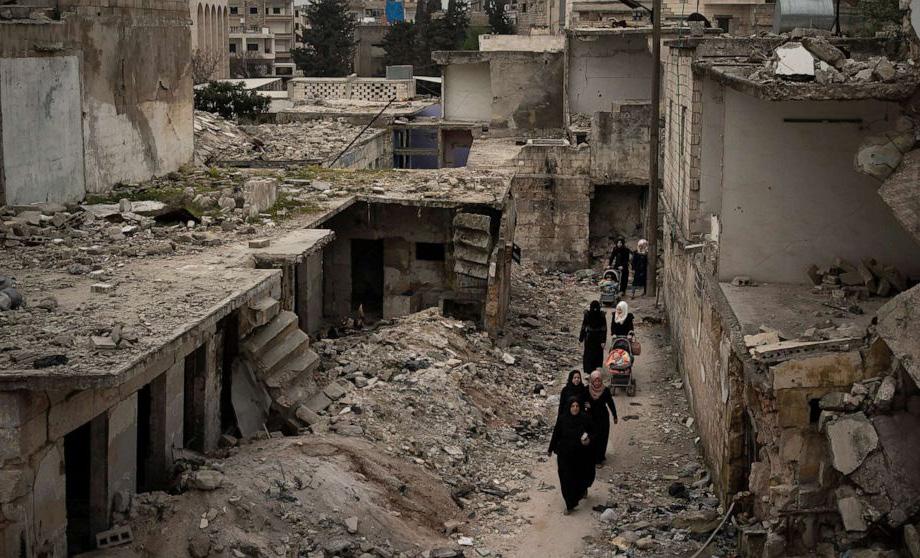
4 minute read
Double Strike in Syria: the Crisis and the Solution
By Woohyun Bryan Suh ‘29 ARTLESS STUDENT WRITER
The ongoing s yrian c ivil War began in March 15th 2011. After over a decade of fighting in the small nation, Syria had found the source of its next terror: The “Türkiye—Syrian Earthquake”.
The Syrian Civil War began in the 15th of March, 2011, fighting for the decrease in the levels of unemployment. The Syrians, observing the corruption in the nation and the lack of political freedom that was presented to them, started protesting and fighting. This was the first of the Syrian Civil War.
Protests against President Assad’s regime (est.2011) rapidly escalated into a full-scale war between the Syrian government backed by Russia and Iran, and anti-government rebel groups helped by the United States, Saudi Arabia, Turkey, and others in the region. Political interests in the Syrian War came from both inside and outside of the Syrian state itself, propelling the conflict into larger and more damaging scales.
These groups of people fought continuously for 11 years in what is still considered an ongoing disaster. 610,000 deaths are attributed to the Syrian Civil War.
The Solution
Some solutions are available to help the Syrian victims in need. Josep Borrell states, “Syria needs to change path. A nard-nosed analysis of the situation shows that the current trajectory of Syria is not sustainable. It will only lead to more instability and hardship”. This statement shows that Syria is lacking in the relationship of their politics. The citizens believe that after over a decade, they [The Syrian Community] suffer every day from this civil war. This rep- resents the unstable policy that is being presented in Syria.
The Türkiye - Syrian Earthquake
The Türkiye - Syrian Earthquake occurred in 2023, near the Türkiye - Syrian border. This affected 24M people, leaving 47,000 dead. The Earthquake had a magnitude of 7.8 being one of the largest earthquakes in Türkiye and Syria. There are two main aspects that are affected by the TürkiyeSyrian Earthquake in 2023: The economic and social elements are particularly prominent.
The economic damage that the Türkiye - Syrian Earthquake caused to both governments was devastating. The whole earthquake will cost up to 85B USD to undo. Considering the amount of money that the Syrian and the Türkiye government will have to make available,there will certainly be an increase in the taxes from the citizens of Türkiye and Syria.
The detriment to the societal aspect that was caused by the Earthquake is in regards to the surviving members of the society. The natural disaster left thousands of people devastated as their sons, families, and their loved ones passed away, facing unimaginable grief and struggles. The solution for this that can be provided by the government is to provide therapy to the people that are mentally detained.
Mudslide and Floods in Brazil: 2022
By Uchan Seo ‘29 ARTLESS STUDENT WRITER
Numerous mudslides and floods happened in Brazil, but not many of them were as deleterious as the mudslide and flood on Brazil 2022 February 15 on Petrópolis, Brazil. The catalyst of the mudslide was torrential rain with the accumulation of months of rainfall (258 mm of rain within 3 hours). It affected both metropolitan parts of Petrópolis and surrounding areas of Fluminense Mountain Region. People with less resources built their homes around the side of the mountain, which led to the ramification of drainage problems and deforestation. As numerous people had been living on the side of the mountain, there were many people who were injured and even killed due to the flood and the mudslide. On February 28, approximately 230 people died from the mudslide and 5 people were missing. About 150 residents have left this region quickly, finding emergency shelters provided by local authorities. On March 15, about 230 crosses had been arranged by the victims’ families and survivors in order to commemorate the tragedy and push the authorities to continue the search for missing people. Petrópolis resident Ana Maria had told BBC News that the February mudslide and flood had destroyed “many dreams along with the city and its inhabitants”. Petrópolis mudslide and floodleft people devastated. Now, the governor said it is the worst rain in more than 90 years and this flood has been recorded as the deadliest flood in the history of Petrópolis. However, the authorities could have suppressed this tragedy from occurring in the first place. From 2007 to 2010, geologists had carried out reports on the risk of flooding in the Quitandinha district, locating vulnerable parts of the city. These risks and dangers pertaining to geological mudslides should have been further discussed and acted upon in Petrópolis, but it was not pursued due to insufficient funding. Local authorities also held a survey in 2017, becoming aware of the fact that about 15,240 houses could have detrimental damages if heavy rainfall that covers 18% of the city occurred. Despite this information, the city did nothing to fortify their houses or carry out preventative measures. Furthermore, the National Natural Disaster Alert Monitoring Center had been informed of the serious magnitude of the mudslide. However, the local authorities did not incentivise and mobilise the residents to evacuate, rather classifying the issue as a simply moderate risk. Considering the financial impacts, the landslide cost more than 1 billion Brazilian Reals to the government, adding to the reduction cost. Moreover, more than 78 million reals worth of the goods were damaged by the mudslide.
Cláudio Castro (the governor of the state of Rio De Janeiro) reacted to the situation with a metaphor equating the city with a war zone. With this catastrophic event, many people were pitiful of the victims and livid at the local authorities who had been oblivious of telling much information to the local citizens about the upcoming mudslide. Although there were tragic consequences, many survivors have had to overcome this hardship, endeavouring to live a semblance of a life before the disaster.








